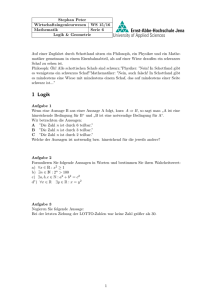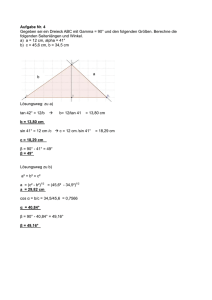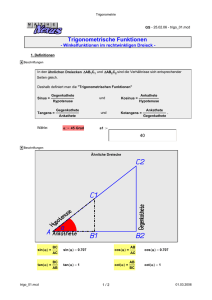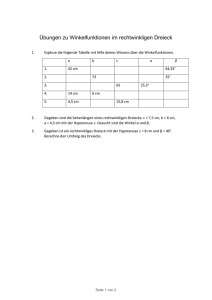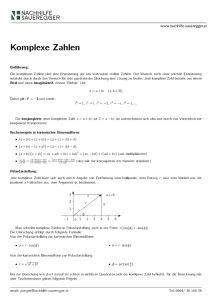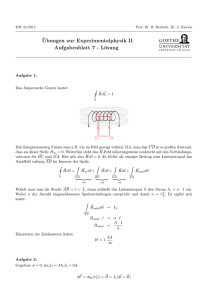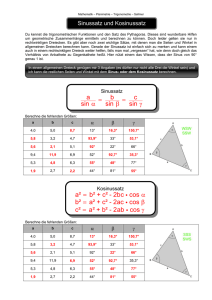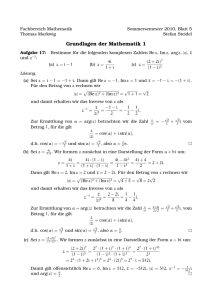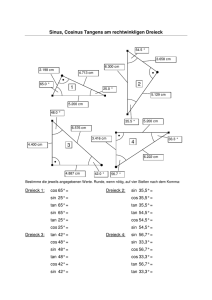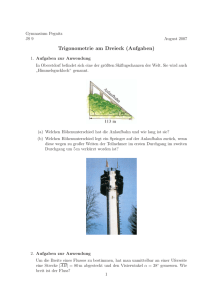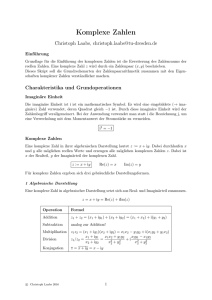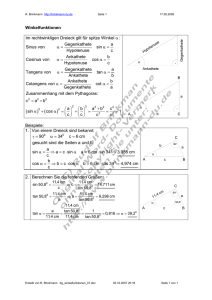Aufgaben und Lernziele zu den Winkelfunktionen
Werbung
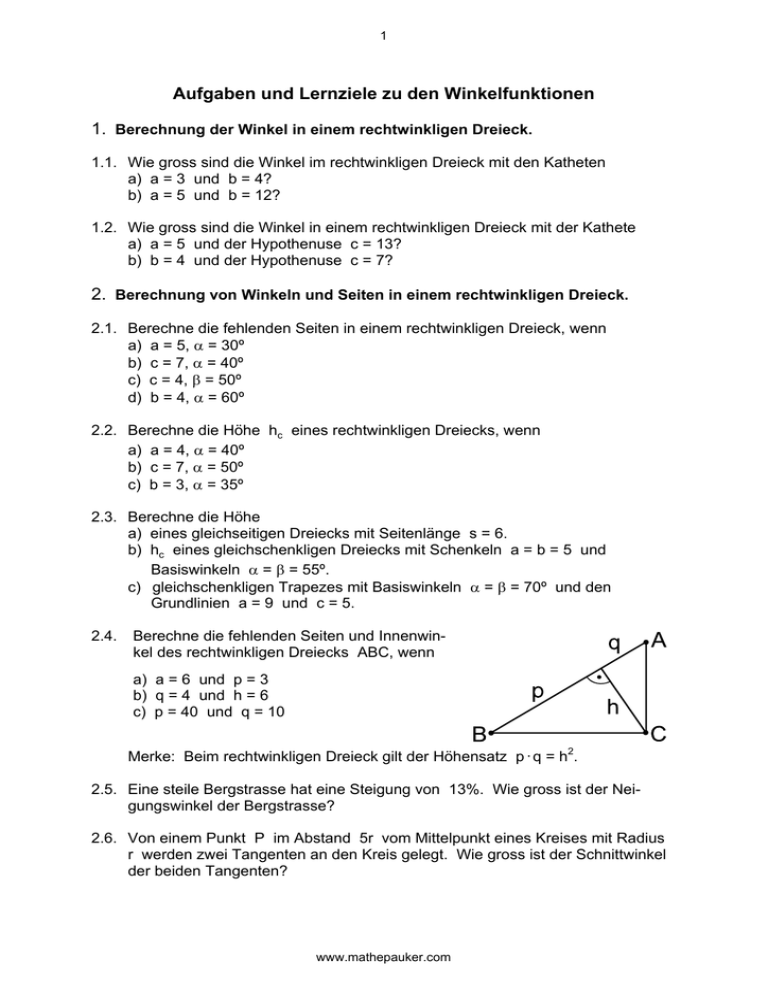
1
Aufgaben und Lernziele zu den Winkelfunktionen
1. Berechnung der Winkel in einem rechtwinkligen Dreieck.
1.1. Wie gross sind die Winkel im rechtwinkligen Dreieck mit den Katheten
a) a = 3 und b = 4?
b) a = 5 und b = 12?
1.2. Wie gross sind die Winkel in einem rechtwinkligen Dreieck mit der Kathete
a) a = 5 und der Hypothenuse c = 13?
b) b = 4 und der Hypothenuse c = 7?
2. Berechnung von Winkeln und Seiten in einem rechtwinkligen Dreieck.
2.1. Berechne die fehlenden Seiten in einem rechtwinkligen Dreieck, wenn
a) a = 5, = 30º
b) c = 7, = 40º
c) c = 4, = 50º
d) b = 4, = 60º
2.2. Berechne die Höhe hc eines rechtwinkligen Dreiecks, wenn
a) a = 4, = 40º
b) c = 7, = 50º
c) b = 3, = 35º
2.3. Berechne die Höhe
a) eines gleichseitigen Dreiecks mit Seitenlänge s = 6.
b) hc eines gleichschenkligen Dreiecks mit Schenkeln a = b = 5 und
Basiswinkeln = = 55º.
c) gleichschenkligen Trapezes mit Basiswinkeln = = 70º und den
Grundlinien a = 9 und c = 5.
2.4.
Berechne die fehlenden Seiten und Innenwinkel des rechtwinkligen Dreiecks ABC, wenn
a) a = 6 und p = 3
b) q = 4 und h = 6
c) p = 40 und q = 10
Merke: Beim rechtwinkligen Dreieck gilt der Höhensatz p · q = h2.
2.5. Eine steile Bergstrasse hat eine Steigung von 13%. Wie gross ist der Neigungswinkel der Bergstrasse?
2.6. Von einem Punkt P im Abstand 5r vom Mittelpunkt eines Kreises mit Radius
r werden zwei Tangenten an den Kreis gelegt. Wie gross ist der Schnittwinkel
der beiden Tangenten?
www.mathepauker.com
2
2.7. Von einem Rhombus kennt man die Seite s und eine Diagonale. Berechne die
Innenwinkel und die andere Diagonale, wenn s = AB = 23 und e = AC =
30.
2.8. Berechne die Länge der Winkelhalbierenden w eines rechtwinkligen Dreiecks
mit Katheten a = 27 und b = 23.
2.9. Berechne den Schnittwinkel der beiden
a) äusseren
b) inneren
Tangenten an zwei Kreise mit Radien r1 = 2 und r2 = 3, wenn für den Abstand
der Kreismittelpunkte M1 und M2 folgendes gilt: M1 M2 = 8.
2.10. Berechne die Länge der Sehne und die Höhe eines Kreissegments eines Einheitskreises mit Zentriwinkel 114º.
2.11. Berechne den Winkel , wenn =
12º.
2.12. Berechne die
Innenwinkel des
Dreiecks ABC.
www.mathepauker.com
3
3. Berechnung der Lösungsmenge von goniometrischen Gleichungen der Art
sin(nx + b) = c, cos(nx + b) = c und tan(nx + b) = c.
3.1. Berechne Lösungen im Bereich 0 360º von
a) sin = cos 43º
b) sin 2 = sin 66º
c) cos = – ½
d) cos 2 = 3 / 2
e) tan 3 = 2
f) sin( – 40º) = cos 48º
g) cos(2 + 46º) = ½
h) sin(2 – 60º) = cos 46º
i) tan(2 – 28º) = 1 / tan(50º)
j) sin 3 = ½
k) cos 3 = 3 / 2
Musterlösungen:
1.1.
a) = arctan(3 / 4) = 36.87º; = 90º – = 53.13º.
b) = arctan(5 / 12) = 22.62º; = 90º – = 67.38º.
1.2.
a) = arcsin(5 / 13) = 22.62º, = 90º – = 67.38º.
b) = arccos(4 / 7) = 55.15º, = 90º – = 34.85º.
2.1.
a)
b)
c)
d)
2.2.
a) hc = 4 · sin(90º - 40º) = 3.064.
b) hc = 7 · cos 50º · sin50º = 3.447.
c) hc = 3 · sin 35º = 1.721.
2.3.
a) h = 6 · sin 60º = 5.196
b) hc = 5 · sin 55º = 4.096
c) hc = ½ (9 – 5) · tan 70º = 5.495.
2.4.
a) = arcos(p / a) = arcos(1 / 2) = 60º, = 90º – = 30º, b = a / tan = 6 / tan
30º = 10.392, c = a / sin = 6 / sin 30º = 12
b) = arctan(h / q) = arctan(3 / 2) = 56.310º, = 90º – = 33.69º, b = q / cos
= 4 / cos 56.310º = 7.211, a = b · tan = 7.211 · tan 56.310º = 10.817, c = b / cos
= 7.211 / cos 56.310º = 13
c) h = p · q = 20, = arctan(h / q) = arctan 2 = 63.43º, = arctan(h / p) =
arctan(1 / 2) = 26.57º, c = p + q = 50, b = c · cos = 22.361, a = c · sin =
44.721
2.5.
arctan(13 / 100) = 7.407º
b = 5 / tan 30º = 8.66 und c = 5 / sin 30º = 10.
a = 7 · sin 40º = 4.50, b = 7 · cos 40º = 5.36.
a = 4 · cos 50º = 2.57 und b = 4 · sin 50º = 3.06.
a = 4 · tan 60º = 6.93 und c = 4 / cos 60º = 8.
www.mathepauker.com
4
2.6.
2 arcsin(1 / 5) = 23.074º
2.7.
= = 2 arccos(15 / 23) = 98.59º, = = 180º – = 81.41º, BD = 2 · 23 ·
sin( / 2) = 34.871
2.8.
w = b / cos(½ arctan(a / b)) = 23 / cos(½ arctan(27 / 23)) = 25.33
2.9.
a) 1 = 2 arcsin((r2 – r1) / M1 M2 ) = 2 arcsin((3 – 2) / 8) = 14.36º
b) 2 = 2 arcsin((r2 + r1) / M1 M2 ) = 2 arcsin((3 + 2) / 8) = 77.36º
2.10. s = 2r · sin( / 2) = 2 · 1 · sin(114º / 2) = 1.6773
h = r (1 – cos( / 2)) = 1 · (1 – cos(114º / 2)) = 0.4554
2.11. 8 / tan = 3 / tan = arctan(8 · (tan ) / 3) = arctan(8 · (tan 12º) / 3) = 29.55º
2.12. = arctan((5 – 2) / (3 – 2)) + arctan((2 – 1) / (6 – 2)) = arctan 3 + arctan ¼ =
85.60º, = arctan((5 – 1) / (6 – 3)) – arctan ¼ = arctan(4 / 3) – arctan ¼ =
39.09º, = 180º – – = 55.30º
3.1. a) {47º,133º} (b) {33º,57º,213º,237º} (c) {120º,240º} (d)
{15º,165º,195º,345º} (e) {20º,80º,140º,200º,260º,320º} (f) {82º,178º}
(g) {7º,127º,187º,307º} (h) {52º,98º,232º,278º} (i)
{34º,124º,214º,304º} (j) {10º,50º,130º,170º,250º,290º} (k)
{10º,110º,130º,230º,250º,350º}
www.mathepauker.com
